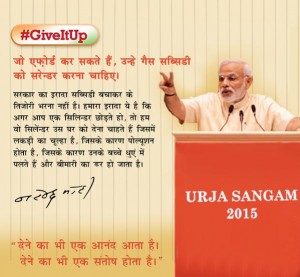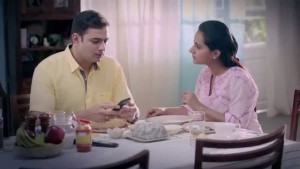“Kya zaroorat hain itna zagmag se event karneka? Make In India simple se bhi to ho sakta hain” (What’s the need for all this extravagance, the Make In India event could have been arranged in simple manner), the elderly sort of man sitting right next to me in the autorickshaw blurted out. It had been a tenuous Monday morning since the auto-wallahs in Mumbai had gone on a flash strike; making the task of finding an auto no less than one of one of Hercules labor. After much consternation and time, had landed myself in a share-auto to BKC, along with two other gentleman who had squeezed in. The fact that all of us were agitated and angry was not surprising, after all when something as mundane as 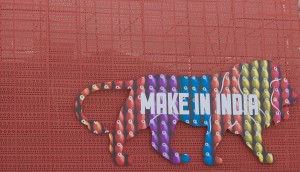 finding an auto becomes an ordeal, something as extraordinary as a Make In India Week (MIIW) seems completely unnecessary. Thus on spotting a green colour media pass for MIIW dangling from my neck, the gentleman in the hard-won share-auto could not help comment. “Auto strike to rokh naheen paya, phir itna bada nautanki kyun?” (The administration could not stall the auto strike, so what is the real need for such an event).
finding an auto becomes an ordeal, something as extraordinary as a Make In India Week (MIIW) seems completely unnecessary. Thus on spotting a green colour media pass for MIIW dangling from my neck, the gentleman in the hard-won share-auto could not help comment. “Auto strike to rokh naheen paya, phir itna bada nautanki kyun?” (The administration could not stall the auto strike, so what is the real need for such an event).
As I alighted the auto and walked past the huge crimson red pavilion with the words “Make In India Centre” emblazoned in huge golden letters, with flags of very many nations fluttering in the foreground, I was thought over the words of the man and was reminded of an anecdotal parable we often share about the way Indians function. It’s the one that has an open dish and Indian cockroaches within it. None escapes, because no sooner one tries to climb out, the rest gang up and pull him 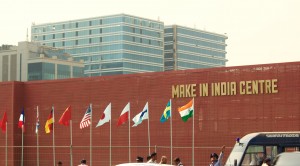 down. Somehow, that anecdote seemed apt to me. It seems that we Indians seem to have a problem with success, especially when it is of our very own. We find it hard to digest, to come to terms with it. So we lash out at it, debunk it, call it useless, futile, nautanki, etc.. That is a typical way in which many react in India. But this trend has exacerbated with the coming the PM Narendra Modi. Everything now is perceived from a political prism, thus, if you don’t agree with him, everything he does has to be negative. So what if it is Skill India or Make In India?
down. Somehow, that anecdote seemed apt to me. It seems that we Indians seem to have a problem with success, especially when it is of our very own. We find it hard to digest, to come to terms with it. So we lash out at it, debunk it, call it useless, futile, nautanki, etc.. That is a typical way in which many react in India. But this trend has exacerbated with the coming the PM Narendra Modi. Everything now is perceived from a political prism, thus, if you don’t agree with him, everything he does has to be negative. So what if it is Skill India or Make In India?
The best instance of this bias could be seen in the way the media in general covered the event. The fourth estate largely avoided talking about the event, or when they did it were the negative aspects were highlighted. So the fire at one of the Make In India event became a talking point. There were talks about mismanagement, the lack of coordination by the organisers, the absence of non-NDA states, and then was all the talk about the quantum of MOUs signed and how much would be realised. These were the things that were talked about, not the fact how many attended or what was on display.
Looking beyond the extravagance
Strangely, jamboree was the appellation that the MIIW has been dubbed by the media at large. The event that was spread over a week, and inaugurated by Prime Minister Narendra Modi himself, has either been ignored or spoken in a b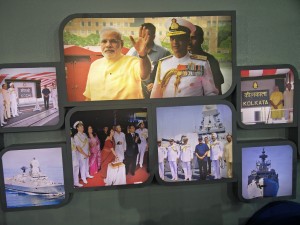 lithe manner. The term jamboree (essentially means a large congregation or party; extravagant and lavish. Usually, a boisterous affair.) is symbolic of that mindset, a perspective that has been tinged with ignorance
lithe manner. The term jamboree (essentially means a large congregation or party; extravagant and lavish. Usually, a boisterous affair.) is symbolic of that mindset, a perspective that has been tinged with ignorance
or naivety. Anyone who visited the event would vehemently argue over the term of reference. The scope and spread of MIIW cannot be expressed as jamboree; it is much beyond those trivial description that hinge largely on size and scale.
But before we come to the very core of what MIIW was, let’s do touch upon its most talked aspect; the size. Indeed, it was one of the most impressive event in terms of scale. Spread over 2,30,000 sq. mt of prime land in Bandra Kurla Complex, there were 27 air-conditioned pavilions that were erected in crimson red.

 Astha TV, all would have been rather fine. But instead, these points were thrown up at the prestigious annual science congress event that took place in Mysore this year. The event is an annual jamboree that travels from one Indian city to another, apparently to promote scientific temperament within the country. Yet, the only thing that this event seems to doing is promote psuedo-relegiousness of the worst kind. Science, the empirical discipline, has taken a back seat to mythology and religion, which has no relation whatsoever with empiricism.
Astha TV, all would have been rather fine. But instead, these points were thrown up at the prestigious annual science congress event that took place in Mysore this year. The event is an annual jamboree that travels from one Indian city to another, apparently to promote scientific temperament within the country. Yet, the only thing that this event seems to doing is promote psuedo-relegiousness of the worst kind. Science, the empirical discipline, has taken a back seat to mythology and religion, which has no relation whatsoever with empiricism.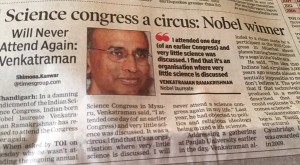 then, Indian-born Nobel laureate Venkatraman Ramakrishnan dubbed the event as “
then, Indian-born Nobel laureate Venkatraman Ramakrishnan dubbed the event as “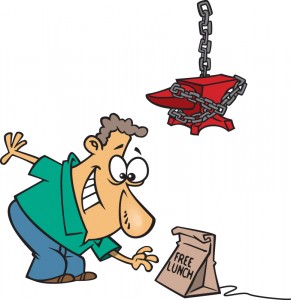
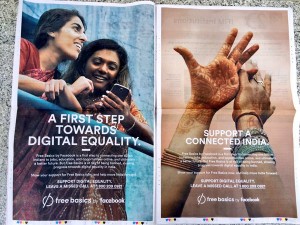 The reason that Mark Zuckerberg is going ballistic this time in India, is because of the manner in why Facebook had been splattered with a cake on its face, the last time round. In fact, it had been just some 6 odd months back when Free Basics in its earlier avatar as Internet.org faced immense resistance by the public at large, and thus was stalled by the Telecom Regulators. At that time, Facebook was taken aback by the power of the collective, by the sheer virality of things. So this time, it kind of came prepared, it repackaged the offering (giving it a kinder overtone), gave the offering an emotional spiel, had the creatives in place, and even Zuckerberg, who is on a paternity leave, is now writing blogs defending the offering.
The reason that Mark Zuckerberg is going ballistic this time in India, is because of the manner in why Facebook had been splattered with a cake on its face, the last time round. In fact, it had been just some 6 odd months back when Free Basics in its earlier avatar as Internet.org faced immense resistance by the public at large, and thus was stalled by the Telecom Regulators. At that time, Facebook was taken aback by the power of the collective, by the sheer virality of things. So this time, it kind of came prepared, it repackaged the offering (giving it a kinder overtone), gave the offering an emotional spiel, had the creatives in place, and even Zuckerberg, who is on a paternity leave, is now writing blogs defending the offering. 

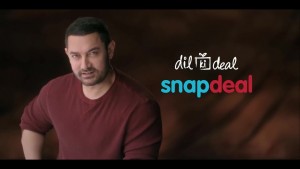 intangible, a brand that people like, associate or even hate. And in the past couple of days (specifically 2), the edifice of the brand, built with time and money, has developed a crack and all because of an event which was totally not in their hands.
intangible, a brand that people like, associate or even hate. And in the past couple of days (specifically 2), the edifice of the brand, built with time and money, has developed a crack and all because of an event which was totally not in their hands. hyper active twitteratis were devising ways coordinating attacks on the online retailer, who just dug the head in the sand waiting for all to blow away. Sadly like those hurricanes in the gulf of Mexico, this one only got stronger. As of penning this piece the app had received some 92000 negative ratings. Then there was the supposed uninstall of some 6 lakh by users, and claimed loses of some 100 crores.
hyper active twitteratis were devising ways coordinating attacks on the online retailer, who just dug the head in the sand waiting for all to blow away. Sadly like those hurricanes in the gulf of Mexico, this one only got stronger. As of penning this piece the app had received some 92000 negative ratings. Then there was the supposed uninstall of some 6 lakh by users, and claimed loses of some 100 crores. immediately constituted a task force with the sole objective of listening and reacting. Thus even as messages on Twitter were going all over, there would be an erudite set of copy-commandos trying to diffuse the situation.
immediately constituted a task force with the sole objective of listening and reacting. Thus even as messages on Twitter were going all over, there would be an erudite set of copy-commandos trying to diffuse the situation. strength? And has she lost it completely? Does she represent anything vital now, apart from being the home of a vast number of human beings? How does she fit into the modern world?
strength? And has she lost it completely? Does she represent anything vital now, apart from being the home of a vast number of human beings? How does she fit into the modern world?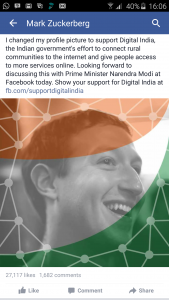 even the CEO of Facebook sporting a DP in support of Digital India. Google in the meantime announced that it will provide free Wi-Fi at 500 railway stations; Microsoft is planning to take broadband connectivity to 5 lakh villages. There is now so much excitement and so much euphoria around the idea, that one feels that there is nothing that can now come between us and our tryst with digitisation. No power on this planet can now stop us from being Digital India. Yeah! Yeah!
even the CEO of Facebook sporting a DP in support of Digital India. Google in the meantime announced that it will provide free Wi-Fi at 500 railway stations; Microsoft is planning to take broadband connectivity to 5 lakh villages. There is now so much excitement and so much euphoria around the idea, that one feels that there is nothing that can now come between us and our tryst with digitisation. No power on this planet can now stop us from being Digital India. Yeah! Yeah!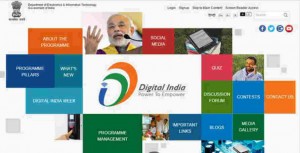
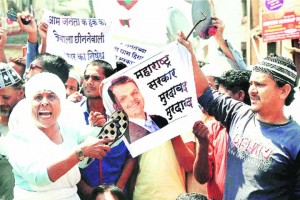 The controversy over the meat ban in Maharashtra, has less to do with Meat more to do with Modi. outrage against the ban has more to do with Narendra Modi as the PM, than the availability of chicken-koliwada on the streets of Mumbai.
The controversy over the meat ban in Maharashtra, has less to do with Meat more to do with Modi. outrage against the ban has more to do with Narendra Modi as the PM, than the availability of chicken-koliwada on the streets of Mumbai. Historically too, Maharashtra and Gujarat were rivals for a long time (even though they did not really exist back then). There is an economic history behind it. The Britishers first established their ‘factory’ in Surat, which essentially was a trading place for Indian goods to be exchanged with those of the British. This made Gujarat (especially Surat) the financial hub. So much so, that when Shivaji was running short of money, he ransacked the city (then under Mughal domination) and made off with much booty. That was essentially the first clash, but it send the agenda for subsequent interactions. When Bombay came into being as a trading post, it were the Parsees from Gujarat that took the lead. When the state of Maharashtra was being created from Bombay Presidency, the Gujjus, especially Morarji Desai opposed it. He had even advocated creating Bombay as a union territory. The rivalry, so, is not really a new one.
Historically too, Maharashtra and Gujarat were rivals for a long time (even though they did not really exist back then). There is an economic history behind it. The Britishers first established their ‘factory’ in Surat, which essentially was a trading place for Indian goods to be exchanged with those of the British. This made Gujarat (especially Surat) the financial hub. So much so, that when Shivaji was running short of money, he ransacked the city (then under Mughal domination) and made off with much booty. That was essentially the first clash, but it send the agenda for subsequent interactions. When Bombay came into being as a trading post, it were the Parsees from Gujarat that took the lead. When the state of Maharashtra was being created from Bombay Presidency, the Gujjus, especially Morarji Desai opposed it. He had even advocated creating Bombay as a union territory. The rivalry, so, is not really a new one.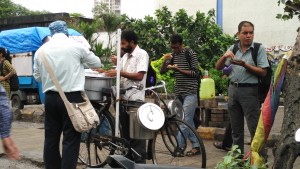 or bad, are all about whether you were able to find a seating place in the train. Chivalries and niceties are easily dumped, when you need to jump a queue and duck into a share auto, even before the lady, who has been patiently standing there for well over 10 minutes. Thus, mornings in Mumbai are chaos supreme, with blood pressures soaring and people zipping from one point to another.
or bad, are all about whether you were able to find a seating place in the train. Chivalries and niceties are easily dumped, when you need to jump a queue and duck into a share auto, even before the lady, who has been patiently standing there for well over 10 minutes. Thus, mornings in Mumbai are chaos supreme, with blood pressures soaring and people zipping from one point to another.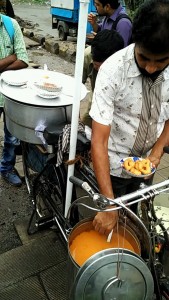 with their meduvadas and idlis (at times even plain dosa). Quickly consumable and awesomely cheap, these Breakfast Annas are an essential part of Mumbai life. People waiting for a bus or a rickshaw, will quickly converge at these anna-spots and savour the goodies. For 10 bucks a plate, you can wallop down 3 small meduwadas or idlis and continue on. These annas are like small pit-stops for the people to come and charge self before rejoining the rush to work.
with their meduvadas and idlis (at times even plain dosa). Quickly consumable and awesomely cheap, these Breakfast Annas are an essential part of Mumbai life. People waiting for a bus or a rickshaw, will quickly converge at these anna-spots and savour the goodies. For 10 bucks a plate, you can wallop down 3 small meduwadas or idlis and continue on. These annas are like small pit-stops for the people to come and charge self before rejoining the rush to work. convey to me, when I asked him to explain the “logic”, the “meaning”, of his artworks. “Why can’t you accept and enjoy the abstract for what they are, without trying to place them in a context?” Gaja asked me, though it seemed more like an advice or a complain.
convey to me, when I asked him to explain the “logic”, the “meaning”, of his artworks. “Why can’t you accept and enjoy the abstract for what they are, without trying to place them in a context?” Gaja asked me, though it seemed more like an advice or a complain.